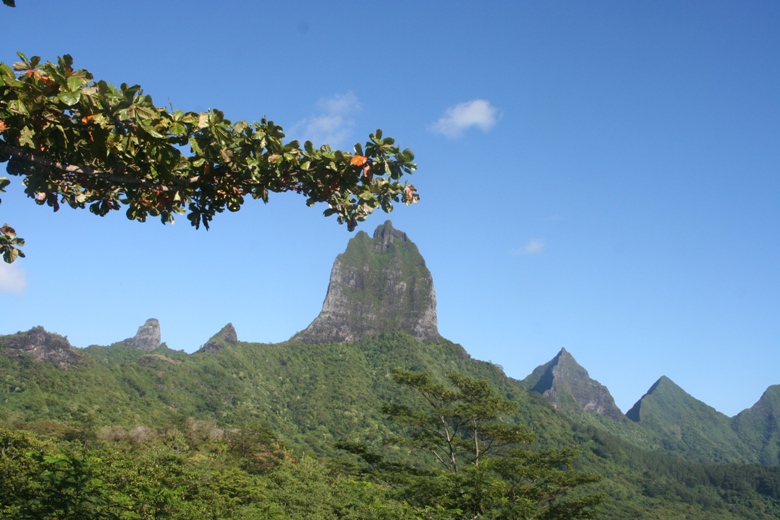One last stop — and beautiful and historic island of Moorea


DAYS 11 & 12 — Another day. Another island in paradise.
We hopped a short flight from Bora Bora to the French Polynesian island of Moorea that is spectacularly beautiful with its crystal clear lagoon and the green cliffs. This island is known less for its manicured resorts than for what there is to do here — taking a hike, passing by ancient marae (ancient temples excavated by archeologists), checking out the spinner dolphins and humpback whales, playing with the stingrays in the crystal clear water.
Click: PHOTO GALLERY The island is an extinct volcano, explains Frank Murphy. Murphy, who is associate director of the University of California Berkley’s research station here. He has also partnered with his friend Paul Sloan to create Tahiti Expeditions (www.tahitiexpeditions.com) to introduce visitors like us to the natural wonders of French Polynesia.
“There is a lot more here than over water bungalows and nice hotels Sloan explains. Both Sloan and Murphy are married to local women and are raising children here in paradise. Lucky guys!
Murphy explains that the geography itself is more dramatic here on Moorea than Bora Bora — more peaks and valleys. Many people come over on the fast ferry from Papeete for the day from the big island of Tahiti. Many people here commute to Papeete for work too — but they are missing a lot, we think.
We’re ensconced in a brand new kind of resort for the islands — The Legends Resort (www.legendsresort.fr). Its spacious villas are perched on stilts up the hill from the Intercontinental Hotel with spectacular views of the lagoon. The spacious villas can sleep six comfortably and the kitchen (all brand new!) saves big bucks on food. There’s a private shuttle service to a private motu to lounge on the beach, a pool here, and one of French Polynesia’s best restaurants at the bottom the hill with desserts to die for (raspberry soufflé?)
James Cook’s final voyage — before he was killed in Hawaii in the late 1770s, included a stop on Moorea. But he never anchored in the bay that today is called Cook’s Bay, Sloan tells us, pointing to the area on Opunuhu Bay where cook anchored, reprovisioning and getting into a famous altercation with a local accused of stealing his goats. When Cook was here, Sloan continues, the population was 45,000. Today, it is maybe a third of that.
We hike through the forest in the Opunuhu Valley, imagining what it must have been like 1500 years ago when the valley was teeming with activity and Tahitians lived and farm here. Murphy stops at a rectangle of rocks. “This was the house,” he said. We try to imagine a farm here — more sun, fewer trees, spectacular views of the bay, terraced fields of bananas, taro, breadfruit. A nice life!
We hike further till we come to a Marae — a kind of individual family temple. They typically pointed toward the mountain, Murphy explains, and each family had one. The custom was to stash the ancestors’ bones somewhere nearby in a special box and then bring them out for special ceremonies. The girls aren’t sure they like that idea!
The night before, we learned a little more about local culture when we visited Tiki Village (www.tikivillage.fr). Owner Oliver Briac conceived the idea more than 20 years ago, he explains, both as a way to introduce tourists to local Tahitian culture and to give local artists a chance to demonstrate their work — from Nano, who is a tattoo master (tattoos are famous here as a symbol of your family history and you see most local men and women sport them), to artists painting paraeos (the fabric women and men wear as a sarongs) to jewelry making and of course dancing.
We see a replica of Paul Gauguin’s thatched roof house and some vanilla vines growing, exhibits of local fruits and vegetables — breadfruit, passion fruit, taro, coconut and even pumpkin. The village has tiny thatched roof huts where the artists work. A bit hokey, sure, but a good place to get a Tahitian 101 lesson in one spot, and a fine spot for kids. About 25,000 tourists visit every year, Briac tells me proudly, enabling local artisans to work here without having to take second jobs at hotels or restaurants.
“Moorea is the most beautiful island,” he says. “Tourists must see that French Polynesia is not just a hotel with water bungalows and a pool but it is the Polynesian way of life.”
Tahitians he adds, are very special people. Family is central to their lives. One artist is carving oyster shells, another is demonstrating traditional cooking over an open hearth (We are treated to a big dinner with everything from grilled Mahi Mahi to local fruits (Great pineapple! ) rice, chicken, fish…
But the best part is the 90-minute dance show that follows dinner. The traditional costumes made from palm leaves, the high headdresses, the green and reds and yellows, the fire dancing. Locals tell me Tahitians will dance just for themselves and it is a treat to watch them perform for us. The fire dancing especially is incredible.
In the end, the visitors are invited to join the dancers. So fun!
The next day, with Paul Sloan and Frank Murphy, we feast on local poisson cru — a kind of marinated raw tuna in salad and coconut milk (it is delicious) at the Blue Pineapple, a local beach front restaurant at the famous Club BaliHai (www.kamaji.com) in the Minnesota North Woods.
“So here we go… we’re at it again… we’re moving out…. We’re moving in…”
END OF FRENCH POLYNESIAN TRAVEL DIARY
